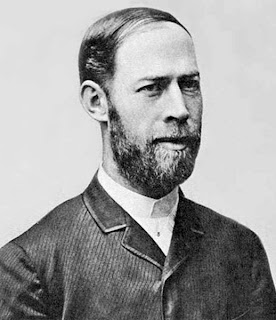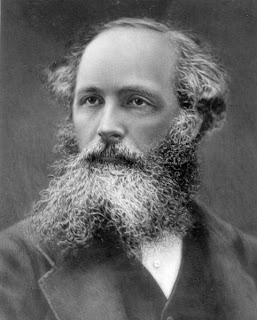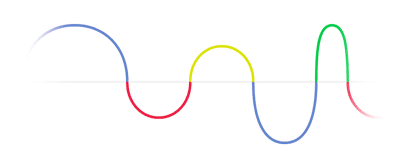Between 1887-1889, based on a series of famous experiments, Heinrich Rudolf Hertz demonstrated the existence of electromagnetic waves predicted by Maxwell's theory, confirming final action by contiguity theory. During experiments the photoelectric effect discovered. In his honor, where electromagnetic waves are called herziene and common unit called Hertz (Hz).
It happened in 1886, the year regarded with great impact on culture, civilization and human development by producing and detecting electromagnetic waves by Heinrich Rudolf Hertz, a brilliant representative of the German scientific spirit. Since antiquity, light, structure and their propagation have been a special concern for philosophers as can be seen even in the treaty of Aristotle's natural philosophy called "Physics". The search for answers, explanations are sought, is seeking physical basis of this phenomenon. Only in 1840 Michael Faraday, experiments on light polarization in the magnetic field, formulate opinions on how theoretical light propagation along the lines of electric and magnetic force.
Another English physicist James Clark Maxwell mathematically possessing an excellent bag, provides the scientific world in 1873, his "Treatise on Electricity and Magnetism," which claimed that the phenomena of electricity and magnetism is due to forces and motion in an environment that calls him simply "ether". This support, Maxwell thinks, contributes to the spread of electricity and magnetism in space. Appreciate the very light (which included the caloric radiation and other radiation) is an electromagnetic disturbance in waves that are transmitted due to the electromagnetic field. In addition, expressing the certainty that all the radiation travels through space at the same speed - the speed of light. But all the hypotheses of Faraday and Maxwell expressed by mathematical analyzes merely a theory and was not matched by a practical experiment. Translation and highlighting previously expressed mathematically radiation were made by young German professor Heinrich Rudolf Hertz.
Born in Hamburg in 1857, Heinrich Rudolf Hertz studied physics at Munich and Berlin, then became assistant to the famous physiologist and physicist Hermann von Helmholtz. Then working as a professor of physics at a high school in Karlsruhe and continued successful research became his passion. 1889 Heinrich Rudolf Hertz mean for nomination as professor at the University of Bonn where he taught physics for a period of only five years. Leave this world in 1894 to only 36, leaving behind a beautiful work, is seen as a brilliant scientist, outstanding exponent of the tradition of German universities.
Reply to Maxwell's mathematical formulations for the formation, propagation and wave propagation speed, Heinrich Rudolf Hertz had to dispose of a first device to produce "disturbances" electromagnetic. Build an electrical oscillator coil Ruhmkorff type, that is an electromagnet, where the mayor was composed of several turns and a secondary number of turns. Secondary was connected to two metallic spheres quite close. When the primary winding was connected intermittently to a galvanic battery, the two spheres appeared ocintilatii. A spark is visible electromagnetic disturbance can not be treated as a continuous phenomenon, seen in the various levels of intensity. Flow of the discharge sparks for Heinrich Rudolf Hertz became a convenient source of electromagnetic radiation.
The next step meant building a detector to emphasize the presence of radiation in space and their propagation velocities. Important detector was disarmingly simple, being essentially a circle with a small wire interstitium. When the oscillator spark and was located near this circle, the circle between the ends open flame appeared. Heinrich Rudolf Hertz discovered the secret of electromagnetic radiation and relativele programs were called radio waves which are shown as radio today. Small circle detector was called electric resonator. Complex oscillator - reasonable toured laboratories to be held and to remove doubts, showing that Maxwell's brilliant insights, thanks have a check genius physicist Heinrich Rudolph practice Hertz. It remained that this fundamental discovery to have a practical application for the benefit of humanity.
After the death of Heinrich Rudolf Hertz in England have been translated and published works on the production and detection of radio waves. A copy of these papers came into the hands of a young man who will read fascinated by the life to put into practice the brilliant discoveries. The young man was none other than Marconi.
Heinrich Rudolf Hertz, the discovery is widely recognized as a genius of humanity, formed and trained at a German school academic honor, the unit of frequency electrical signals bears his name: Heinrich Rudolf Hertz, a name that is found in textbooks in physics treaties, in encyclopedias, but also in all documents and prospectuses appliances based their operation on the coil resonator oscillators and circle.
Heinrich Rudolf Hertz
Details about Heinrich Rudolf Hertz's life and his inventions
Wednesday, February 22, 2012
Tuesday, February 21, 2012
Heinrich Rudolf Hertz celebrated by Google at 155 years since birth
Heinrich Rudolf Hertz is celebrated by Google at 155 years since birth (b. 1857).
Hertz, German physicist, was born on February 22, 1857 in Hamburg, died at January 1, 1894, Bonn.Inclinations proved early in the trades: carpentry taught and worked on the lathe.
At age 18 he finished high school and had the impression that is intended profession inginer.Sa went to study engineering in Munich, but after two years since studies found that it attracts more scientific work in physics.
Then he moved to the University of Berlin, where he began to study mathematics and physics. Particularly diligent student was noticed by renowned physics professor Herman von Helmholtz, who took him as a practitioner in his laboratory.
Hertz first discovered in Karlsruhe with the existence of electromagnetic wave oscillator. He proved that they are identical waves moving at the speed of light. His results do was the basis for development of wireless telegraphy and radio.
In 1888, Heinrich Rudolph Hertz (the frequency from which the unit name) shows that perturbations generated by a spark coil, the characteristics of radio waves as they are described by Maxwell. His work is continued by Guglielmo Marconi in experimental wireless telegraphy, which use Morse code. By 1896, Marconi transmitted messages over a distance since several miles.
Unit frequency, Hertz is named after him.
Hertz, German physicist, was born on February 22, 1857 in Hamburg, died at January 1, 1894, Bonn.Inclinations proved early in the trades: carpentry taught and worked on the lathe.
At age 18 he finished high school and had the impression that is intended profession inginer.Sa went to study engineering in Munich, but after two years since studies found that it attracts more scientific work in physics.
Then he moved to the University of Berlin, where he began to study mathematics and physics. Particularly diligent student was noticed by renowned physics professor Herman von Helmholtz, who took him as a practitioner in his laboratory.
Hertz first discovered in Karlsruhe with the existence of electromagnetic wave oscillator. He proved that they are identical waves moving at the speed of light. His results do was the basis for development of wireless telegraphy and radio.
In 1888, Heinrich Rudolph Hertz (the frequency from which the unit name) shows that perturbations generated by a spark coil, the characteristics of radio waves as they are described by Maxwell. His work is continued by Guglielmo Marconi in experimental wireless telegraphy, which use Morse code. By 1896, Marconi transmitted messages over a distance since several miles.
Unit frequency, Hertz is named after him.
Who was Heinrich Rudolf Hertz?
Well, in case you was wondering who was Heinrich Rudolf Hertz...
The short answer is: The one which name was given to the frequency unit.
Hertz's work in the field of electromagnetic waves were of fundamental importance for further development of science, which led ultimately to the discovery of radio, the Russian Aleksandr Stepanovich Popov, the first radiograph, in 1896, sent two words: "Heinrich Hertz"
The short answer is: The one which name was given to the frequency unit.
Hertz's work in the field of electromagnetic waves were of fundamental importance for further development of science, which led ultimately to the discovery of radio, the Russian Aleksandr Stepanovich Popov, the first radiograph, in 1896, sent two words: "Heinrich Hertz"
Details about Heinrich Rudolf Hertz
Heinrich Rudolf Hertz was a German physicist, he was born in the family of a lawyer and a senator from Hamburg. He studied at the universities of Munich and Berlin. In 1883 he became private lecturer for theoretical physics at Christian-Albrecht University of Kiel.
Between 1885 and 1889 he was professor of physics at the Technical University of Karlsruhe. From 1889 he was professor of physics at Friedrich-Wilhelms-Universität Rheinischen of Bonn. Hertz died at only 37 years of Wegner's granulatoza.
Hertz first discovered in Karlsruhe with the existence of electromagnetic wave oscillator.
He proved to be the same and moving the same speed as light waves. The results were the basis for development of wireless telegraphy and radio.
Subscribe to:
Posts (Atom)


